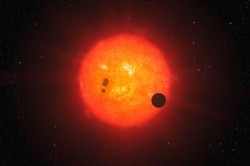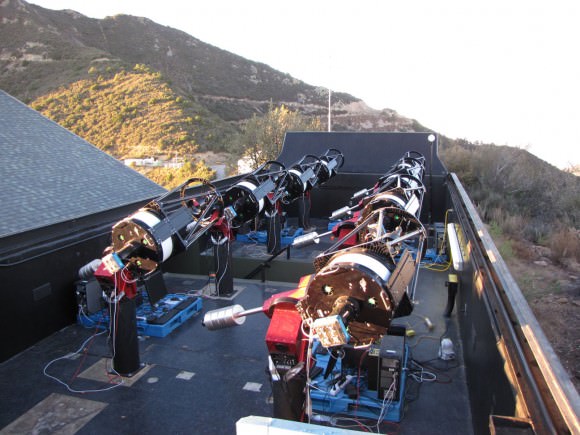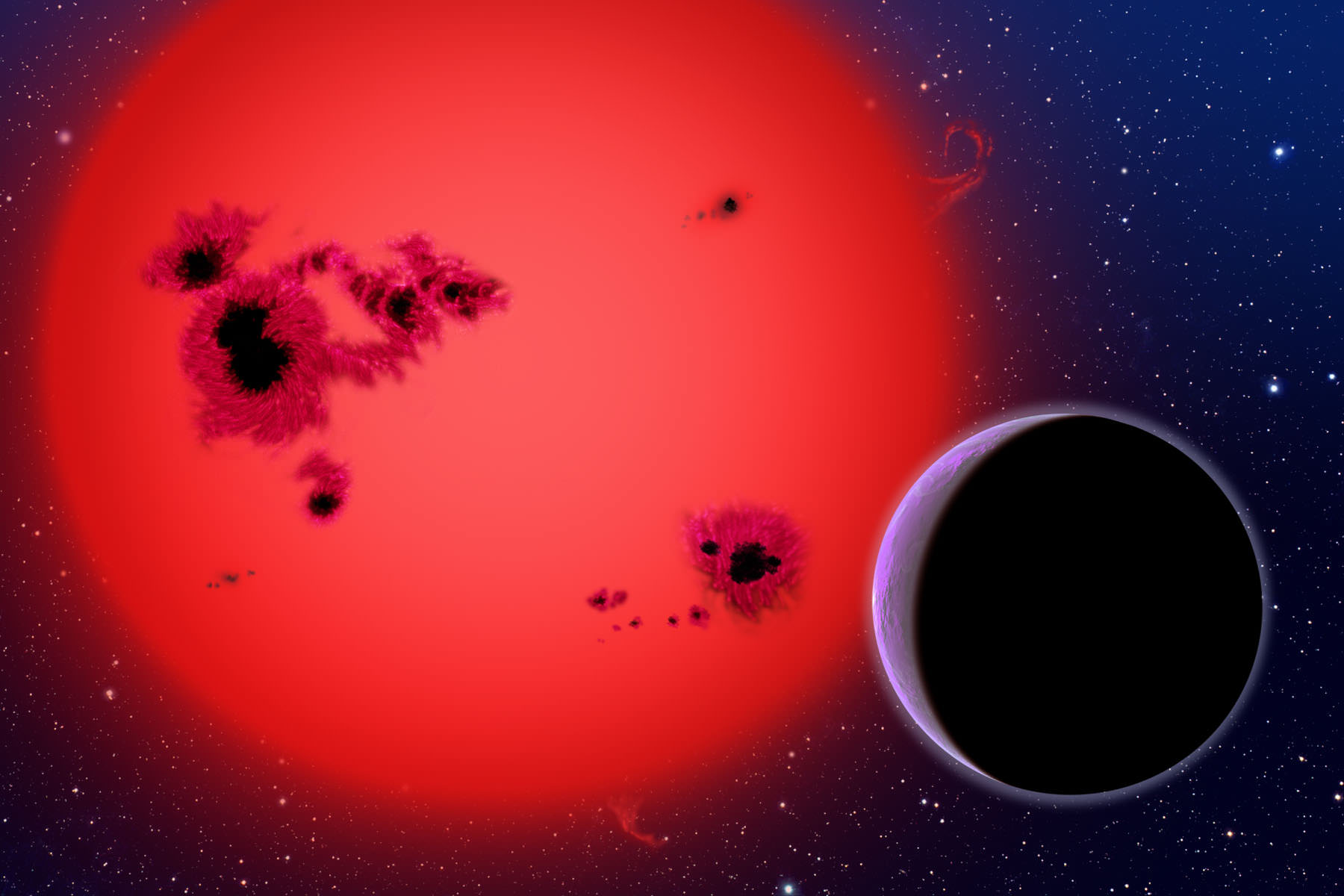This artist’s conception shows the newly discovered super-Earth GJ 1214b, which orbits a red dwarf star 40 light-years from our Earth. Credit: Credit: David A. Aguilar, CfA
More exoplanets this week! Today astronomers announced the discovery of so called super-Earth around a nearby, low-mass star, GJ1214. The newly discovered planet has a mass about six times that of Earth and 2.7 times its radius, falling in between the size of Earth and the ice giants of the Solar System, Uranus and Neptune. But this latest exoplanet, GJ1214b, has something else, too: an atmosphere about 200 km thick. “This atmosphere is much thicker than that of the Earth, so the high pressure and absence of light would rule out life as we know it,” said David Charbonneau, lead author of a paper in Nature reporting the discovery, “but these conditions are still very interesting, as they could allow for some complex chemistry to take place.”
GJ1214b is also a very hot place to be. It orbits its star once every 38 hours at a distance of only two million kilometres — 70 times closer to its star than the Earth is to the Sun. “Being so close to its host star, the planet must have a surface temperature of about 200 degrees Celsius, too hot for water to be liquid,” said Charbonneau.
However, another member of the team said water ice could possibly be present on GJ1214b, deep inside the heart of the planet. “Despite its hot temperature, this appears to be a waterworld,” said graduate Zachory Berta who first spotted the hint of the planet among the data. “It is much smaller, cooler, and more Earth-like than any other known exoplanet.”
The star is a small, red type M star about one-fifth the size of our Sun. It has a surface temperature of only about 2,700 C (4,900 degrees F) and a luminosity only three-thousandths as bright as the Sun.

Charbonneau compared this new exoplanet to Corot-7b, the first rocky super-Earth found using the transit method, when the planet’s orbit is takes it across the face of its parent star, from our vantage point. .
The astronomers were also able to obtain the mass and radius of GJ1214b, allowing them to determine the density and to infer the inner structure.
Although the mass of GJ1214b is similar to that of Corot-7b, its radius is much larger, suggesting that the composition of the two planets must be quite different. While Corot-7b probably has a rocky core and may be covered with lava, astronomers believe that three quarters of GJ1214b is composed of water ice, the rest being made of silicon and iron.
“The differences in composition between these two planets are relevant to the quest for habitable worlds,” said Charbonneau. “If super-Earth planets in general are surrounded by an atmosphere similar to that of GJ1214b, they may well be inhospitable to the development of life as we know it on our own planet.”
The atmosphere was detected when the astronomers compared the measured radius of GJ1214b with theoretical models of planets. They found that the observed radius exceeds the models’ predictions, and deduced that a thick atmosphere was blocking the star’s light.
“Because the planet is too hot to have kept an atmosphere for long, GJ1214b represents the first opportunity to study a newly formed atmosphere enshrouding a world orbiting another star,” said Xavier Bonfils, another member of the team. “Because the planet is so close to us, it will be possible to study its atmosphere even with current facilities.”

The planet was first discovered as a transiting object within the MEarth project, which follows about 2000 low-mass stars to look for transits by exoplanets, and uses a fleet of eight small, (16-inch) amateur-sized ground-based telescopes.
To confirm the planetary nature of GJ1214b and to obtain its mass (using the so-called Doppler method), the astronomers needed the full precision of the HARPS spectrograph, attached to ESO’s 3.6-metre telescope at La Silla.
The next step for astronomers is to try to directly detect and characterize the atmosphere, which will require a space-based instrument like NASA’s Hubble Space Telescope. GJ1214b is only 40 light-years from Earth, within the reach of current observatories.


Confused:
“the planet must have a surface temperature of about 200 degrees Celsius, too hot for water to be liquid”
“astronomers believe that three quarters of GJ1214b is composed of water ice, the rest being made of silicon and iron.”
So…a solid surface with frozen water ice and a very hot atmosphere?
Exactly what I was going to say.
Since the habitable zone of small Class M stars are negligible, I can’t see they are really expecting to find a planet with life around any of them. Unfortunately, most of the stars nearby us are this type.
However, this doesn’t mean studying them is useless. Finding any planet and figuring out its composition, of that of its atmosphere will help us find out many things… many of which we have the wrong answers to now… Welcome to Cosmology!
One hope is being able to find and interrogate smaller planets around smaller and dimmer stars will hopefully allow us to perfect methods to find them around G class stars.
“This atmosphere is much thicker than that of the Earth, so the high pressure and absence of light would rule out life as we know it,”
Does anyone know why a high pressured atmosphere can’t sustain life? Organisms live at the bottom of oceans at high temperature hydrothermal vents, so why couldn’t there be such a set up on a planet like this?
The plaent is likely tidally locked with the star. So one face is very hot while the other might be very cold. With water, or water vapor, at this temperature I suspect there might be a huge amount of atmospheric turbulence. At 200C and at those atmospheric pressures there is likely considerable liquid-vapor phase transitions going on. The latent heat produced will generate lots of kinetic energy. This is the source for cumulus updrafts and winds during storms. So this planet may be perpetually covered in massive storms which equilibrate temperature around its surface. Also if CO_2 is a major component of the atmosphere there is likely considerable heat trapped.
This planet is probably a large and cooler version of Venus, but with water activity. This is not likely a welcoming place for life.
LC
To compare, apparently Venus atmosphere is ~ 250 km thick. [Wikipedia.]
Let me see if I get this.
Classical habitable zone (i.e Earth analogs) around M stars is ~ 0.06 – 0.2 au, classical habitable zone (HZ) around G stars ~ 0.8 – 1.3 au. [Eye-balling fig 1 in “What makes a planet habitable?”, Lammer et al Astron Astrophys Rev 2009.] Volume factor ~ (0.14/0.5)^3 or ~ 0.02 or 2 order of magnitudes less HZ.
Number of M stars to G stars 76 % to 8 % in Sun neighborhood. [“Stellar classification”, Wikipedia.] Volume factor ~ 76/8 or ~ 10 or 1 order of magnitude more HZ.
So expected number of habitable exoplanets around M stars is net one order of magnitude less, all else equal. (Actually a factor 5.)
Is that so bad that we aren’t “really expecting to find” any at all?
Apparently cosmologists are a tough crowd to please. 😀
@ Kawarthjon:
I don’t share pessimism in tidal locked planets or planets close to solar wind energetic M stars as being completely inhabitable. Mendez has a neat definition of habitability as in biomass (as a proxy for energy) productivity presented in a couple of papers.
Looking at Earth he finds the universals temperature and humidity as independent and well explaining factors of habitability. So, no, pressure is a weak constraint for life as we know it. Bacterias can withstand tens of atmospheres pressure differentials and hundreds of atmospheres total pressure in our oceans.
Tidal locking or solar wind energetics are then respectively inhibiting respectively promoting habitability.
The problem then is that you can now separate out the difficulty of abiogenesis, when life was less sturdy and metabolically and reproductively efficient. Apparently life could have an expected sloppy biochemistry and still get going under the high power source of sun light at moderate temperatures.
But referring to later days extremophiles as proxies for life during abiogenesis isn’t very convincing. There is a paper from early this year that looked at DNA nucleotide ratios and protein structures as proxies for temperature during organisms development, and the later as proxy for gene phylogeny. I.e. there is redundancy freedom in the genetic code that can be selected for by temperature bottlenecks, DNA can code the same proteins but survive different high temperatures. Proteins can work at different temperatures depending on which basic structures, “folds”, they consist of. And finally there is a certain traceable phylogeny in original “primitive” protein structures that evolved.
Eukaryote DNA could not be used, but the rest could. Seems that proteins, developed as life left the original RNA world, originated at a mild 20 Celsius.
Later days DNA has in bacteria and archaebacteria bottlenecked through 70 Celsius, which is roughly the temperature the sediment chert isotopic ratios gives for most of Earth Archaean history. (Another paper from 2006 IIRC, with temperatures from ~ 70 Celsius @ 3.5 Ga down to ~ 50 Celsius at 2 Ga or so.)
That may tell us that abiogenesis happened for us at clement conditions, and that you have to abandon RNA for DNA (if it hadn’t already happened) as soon as the CO2 atmosphere gets dense enough for a hot green house during the last volatile collection.
In any case, abiogenesis-able planets may easily be much less planets than there are potentially habitable ones.
[In our case it seems the last volatile collection was at the Last Heavy Bombardment, if the latest isotope ratio observations of Earth noble gas content is correct. Which means life likely started well before it was ended at 3.8 Ga. I’ve seen papers claiming that the LHB impossibly could have sterilized Earth, cells procreate and move around faster than the sterilization volumes in their impact models.
Likely life started ~ 4 Ga as per above. Earth solidified at ~ 4.4 Ga and got oceans at ~ 4.2 Ga. From oceans to life in ~ 200 My or less. If that holds up, that was fast and early life. Awesome!]
Oops! Tidal locking or solar wind energetics are then respectively inhibiting (too hot: ~ 40 Celsius and 100 % humidity is ideal) respectively promoting (more energy to feed on) habitability.
Life is not impossible, but I think unlikely. There is a habitable zone around M class stars, but planets tidal lock. I did the analyses on the Gliese 581 planet found a couple of years ago, and ran the numbers to find it is probably tidally locked. A planet in the habitable zone of an M-class start might bear life if the planet is similar to Earth with a large moon. In this way the tidal locking might be considerably delayed, since the tidal force acts on an extended 2-body system with a much larger net angular momentum. So we might imagine some double planet, a planet with a large moon, which are mutually locked and where the moon is comparatively close to the larger planet. If the moon is in a close orbit with a periodicity comparable to several Earth days, then the stellar tidal locking would take much longer to be established.
Of course there are issues of 3-body stability, but that is too complicated to figure out here. At any rate with the Gliese planet I found it would have become tidal locked within about 1,000,000 years after its formation. The tidal locking sets in pretty quickly if you are that close to the star, ~ .067AU. This planet is even closer at .014 AU. The time for tidal locking scales as freq/(M^2R^5). If I compare this to the Gliese result the time for the tidal acceleration to lock the planet is about 1000 times shorter. So it was locked within thousands of years of its formation, and was probably formed in a locked position. Yeah, this planet is locked!
Life can exist at high temperatures, such as at mid oceanic vents, but they exist because of a heat flow. Their source of energy is the flow of heat from the source into a cold bath. A region which has a uniformly hot temperature does not provide a flow of heat, or energy, which is required to drive biological processes. I doubt there is photosynthesis, for with that amount of atmosphere I would imagine there is little light which reaches the surface. I don’t know what the lighting conditions are on Venus, but I imagine things are fairly dark.
LC
Re: the ices question.
If you check the expanded phase diagram for water, you’ll find that, at large pressures, you get ices even at large temperatures. It’s not the ice we are accustomed to, of course, which is known as “type I ice”, but it’s different kinds of ices, known as type VI and type VII ices. There are also types II, III, IV and V, but those are all low-temperature (and high-pressure) ices.
@LBC:
I am also under the assumption that this exoplanet is tidally locked, with a likely temperature of more than -100 Celsius on it’s dark side. What are the parameters indicating that a planet will be tidally locked? Mass of the planet? Distance from the star? Other factors?
@SuperKevin: If the exoplanet is tidally locked, perhaps the dark side could contain water ice, but I don’t believe that water ice could exist over three quarters of the surface, as the article states. I’m confused as well.
The equation for the time it takes for tidal locking to set in is
T_{lock} = [omega*a^6*I/(3GMR^5)]x(Q/k)
where omega is the angular velocity (spin) of the satellite, I the moment of inertia I = (2/5)mr^2 (m = mass of planet, r = radius of planet), G Newtons constant of gravitation, M the mass of the star, R the radius from the star, and Q and k are the tidal dissipation and the Love number. The last two are empirical numbers and usually Q/k ~ 100 to 1000.
Such a tidally locked planet might have a zone of acceptable conditions tangent to the radial vector to the star. However, with a huge thick atmosphere such as this it could be that temperatures are distrubuted somewhat uniformly. This happens with Venus, where the long night side of the body is not much cooler than the day side of the planet. Venus has something like less than two days or Venusian sols per one year as I recall.
LC
A paper describing three possible origins for the ‘gas layer’ on GJ1214b was posted on arXiv today: http://arxiv.org/PS_cache/arxiv/pdf/0912/0912.3243v1.pdf . The authors favor a water planet scenario and go on to explain:
“…in this scenario, given our water EOS and reasonable assumptions for the planet albedo and interior luminosity, GJ 1214b would be a so-called hot-ocean planet with an outer steam atmosphere that transitions continuously to a superfluid without passing through the liquid phase. Regardless of the true nature of GJ 1214b, the relatively low density means it is certainly a new kind of planet with no solar system analogs.”
Like they say, whatever turns out to be the case, this planet is for now in a class by itself.
The discovery paper by Charbonneau et. al. can be found here: http://arxiv.org/ftp/arxiv/papers/0912/0912.3229.pdf .
This planet is a bit of an oddity. If the planet is largely water half way down its radial extent or so I doubt there is any life there.
I have not looked at this paper. When I hear superfluid I think according to liquid helium and supercooled quantum fluids. Clearly that is not meant here.
LC
Good stuff Jon.
It is amazing just how different planets seem to be from one another.
This one is just a bit more out of the ordinary, since models do tend to lean towards inner planets holding water early in their life… however, those this close don’t hold their water for long.
… as normal. The more we learn, the more ignorant we become!
@Jon Hanford:
Thanks for the link to the paper. I skimmed it briefly, will read in more detail when time permits.